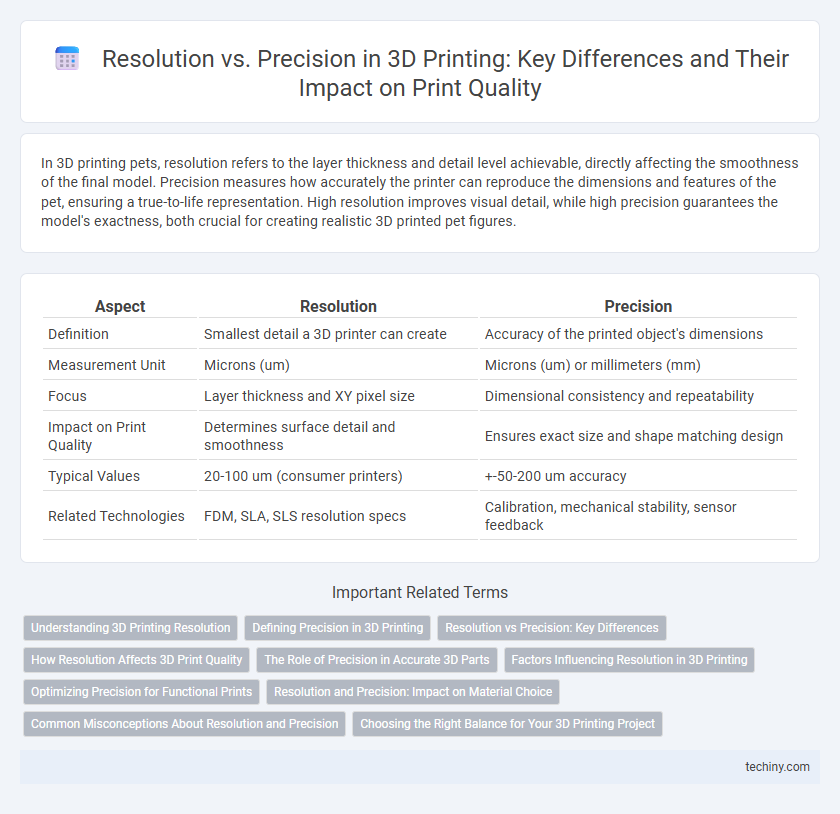In 3D printing pets, resolution refers to the layer thickness and detail level achievable, directly affecting the smoothness of the final model. Precision measures how accurately the printer can reproduce the dimensions and features of the pet, ensuring a true-to-life representation. High resolution improves visual detail, while high precision guarantees the model's exactness, both crucial for creating realistic 3D printed pet figures.
Table of Comparison
| Aspect | Resolution | Precision |
|---|---|---|
| Definition | Smallest detail a 3D printer can create | Accuracy of the printed object's dimensions |
| Measurement Unit | Microns (um) | Microns (um) or millimeters (mm) |
| Focus | Layer thickness and XY pixel size | Dimensional consistency and repeatability |
| Impact on Print Quality | Determines surface detail and smoothness | Ensures exact size and shape matching design |
| Typical Values | 20-100 um (consumer printers) | +-50-200 um accuracy |
| Related Technologies | FDM, SLA, SLS resolution specs | Calibration, mechanical stability, sensor feedback |
Understanding 3D Printing Resolution
3D printing resolution refers to the smallest feature size a printer can produce, directly impacting the level of detail in the final model. Precision describes the printer's ability to repeatedly reproduce the same dimensions accurately across multiple prints. Understanding the distinction between resolution and precision is essential for optimizing print quality, especially when working with complex geometries or fine details.
Defining Precision in 3D Printing
Precision in 3D printing refers to the ability of a printer to consistently reproduce detailed features and dimensions across multiple prints, ensuring accuracy in the final object. It is measured by the repeatability of the printer's movements and the stability of the printing process, which directly affects the quality of fine details and surface finish. High precision enables complex geometries to be produced with minimal variation, critical for applications in aerospace, medical devices, and prototyping where exact measurements are essential.
Resolution vs Precision: Key Differences
Resolution in 3D printing refers to the smallest feature size a printer can create, determined by layer height and XY accuracy, while precision measures the printer's ability to consistently reproduce the same dimensions across multiple prints. High resolution enables finer details and smoother surfaces, whereas high precision ensures dimensional accuracy and repeatability in complex parts. Understanding the key differences between resolution and precision is crucial for selecting the right 3D printer for applications requiring either detailed aesthetics or functional consistency.
How Resolution Affects 3D Print Quality
Resolution in 3D printing directly impacts the level of detail and surface smoothness achievable in the final model, as higher resolution allows for finer layer thickness and more accurate replication of intricate features. Precision, while related, refers to the printer's ability to repeatedly produce parts within tight tolerances, but it is the resolution that primarily dictates the visual quality and sharpness of details. Optimizing resolution settings enhances print clarity, reduces visible layer lines, and improves the overall fidelity of complex geometries in 3D printed objects.
The Role of Precision in Accurate 3D Parts
Precision in 3D printing defines the printer's ability to consistently reproduce exact dimensions, directly impacting the accuracy of complex parts. High precision ensures that repeated prints maintain tight tolerances, crucial for functional prototypes and end-use components where exact fit and mechanical performance are required. While resolution dictates the smallest detail a printer can render, precision governs dimensional fidelity, making it essential for producing accurate, reliable 3D parts in industrial applications.
Factors Influencing Resolution in 3D Printing
Resolution in 3D printing is primarily influenced by layer height, nozzle diameter, and the printer's mechanical stability, which collectively determine the minimum detail achievable per print. Material properties such as viscosity and curing behavior affect resolution by impacting how precisely layers adhere and solidify. Environmental factors like temperature control and vibration can also alter resolution by introducing inconsistencies during the printing process.
Optimizing Precision for Functional Prints
Optimizing precision in 3D printing is crucial for producing functional prints with accurate dimensions and reliable mechanical properties. Higher precision allows for tighter tolerances, minimizing post-processing and ensuring parts fit together seamlessly in assemblies. Focusing on machine calibration, material selection, and slicing settings enhances precision, directly impacting the quality and usability of functional prototypes and end-use components.
Resolution and Precision: Impact on Material Choice
Resolution in 3D printing refers to the smallest feature size a printer can produce, directly influencing the level of detail achievable in a print. Precision relates to the printer's ability to repeatedly produce parts within tight dimensional tolerances, which affects the fitting and function of components. Material choice impacts both resolution and precision, as materials with consistent flow properties and appropriate curing behaviors enable finer resolution and higher precision, while materials prone to warping or shrinkage limit achievable detail and dimensional accuracy.
Common Misconceptions About Resolution and Precision
Resolution in 3D printing refers to the smallest layer height or feature size a printer can produce, while precision describes the consistency or repeatability of producing the same dimensions. A common misconception is that higher resolution automatically means better precision, but a printer can have fine resolution yet suffer from variability due to mechanical or material factors. Understanding the difference helps optimize 3D print quality by addressing both the printer's capability to create detailed features and its ability to replicate them accurately.
Choosing the Right Balance for Your 3D Printing Project
Selecting the optimal balance between resolution and precision in 3D printing significantly impacts the final print quality and functional performance. High-resolution settings enhance surface detail by reducing layer height, while precision ensures dimensional accuracy critical for mechanical fits and assemblies. Evaluating project requirements such as detail complexity and tolerance levels guides the choice, optimizing print time, material usage, and energy consumption.
Resolution vs Precision Infographic

 techiny.com
techiny.com